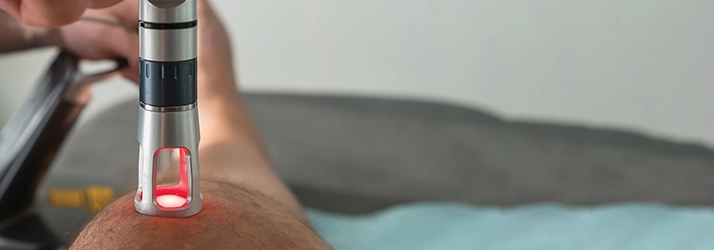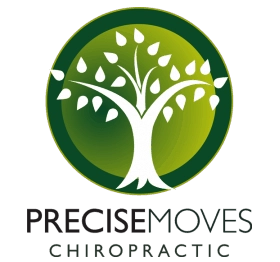Cold Laser in San Francisco CA

Dr. Gregory is an expert at treating sports injuries, carpal tunnel, tennis elbow, frozen shoulder, and many other bio-mechanical problems occurring through repetitive actions, sports, or long hours at work. Dr. Gregory is leading the way with cold laser treatments in San Francisco CA combined with chiropractic care.
Does Cold Laser Therapy Work in San Francisco CA?
Yes! Cold laser therapy is a safe and effective method to helping with pain relief and healing. There have been over 4,000 studies showing the positive effects of cold laser.
We use Microlight ML830® and TerraQuant Laser because they are low energy cold lasers that are safe, noninvasive, light-emitting, medical devices. Both have been approved by the FDA for use in the treatment of a variety of soft tissue problems and neurological disorders.
Cold lasers have been used in medical facilities for over 30 years and have a long record of successful clinical studies demonstrating medical efficacy and safety.
What is Cold Laser or Low Level Laser Therapy?
Cold laser units come in various sizes and shapes. Often the units used are handheld and similar to the size of an average flashlight. The treatment time required is usually dependent on two factors, the condition being treated and the size of the area affected. A major advantage of cold laser therapy units is the ability to penetrate deep into tissues and joints while retaining the capability to also treat conditions closer to the skin surface. People utilizing cold laser therapy as a non-invasive form of treatment report feeling little or no sensation during the treatment process. Regardless of how deep the light waves penetrate, the energy is eventually absorbed by the damaged cell providing it with the boost to begin working. Plants using the sun's light to stimulate growth and healing is a good analogy to demonstrate the effects of cold laser therapy. As these cells are repaired, the body is able to decrease the sensation of pain, reduce swelling, and accelerate the time required to heal.
What does cold laser do?
Studies have shown that using a cold laser can significantly accelerate and enhance your body’s natural defense to injury which will result in decreasing inflammation and quicken rehabilitation and repair after an injury allowing you to speed up healing and get you back to normal again.
Cold lasers have been used in medical facilities for over 30 years and have a long record of successful clinical studies demonstrating medical efficacy and safety. Below are some of the health benefits of cold laser.
Increases:
- Collagen production
- Nerve regeneration
- Vasodilation
- Cell metabolism
- Cell membrane potential
- Microcirculation
- Tissue and bone repair
- Lymphatic response
- Enzyme response
Reduces:
- Swelling time and magnitude of pain and inflammation
How does cold laser work?
Laser therapy stimulates your body’s natural healing power at a cellular level. The Cold Laser uses what is called “Photon energy” which is basically the energy produced by light, to stimulate the activity of your cell and its components. This therapy is effective, painless, and best of all you don’t have to take a drug to feel the effects.
What conditions can be treated?
Cold laser or Low Level Laser Therapy (LLLT) is successful at treating many conditions whether it happened today or years before. This therapy also helps heal repetitive conditions such as... straining your musculo-skeletal system, spraining an ankle. It also helps with Plantar Fasciitis!
Symptoms and conditions benefited by cold laser:
- Repetitive Stress Injuries (RSI)
- Acute or chronic back pain
- Acute or chronic neck pain
- Carpal Tunnel Syndrome (CTS)
- Tennis/Golf elbow
- Sport Injuries
- Headaches & TMJ disorders
- Arthritis
- Tendonitis
- Fibromyalgia
- Shoulder / Rotator Cuff
- Soft Tissue Injuries
- Knee & Ankle pain
- Bursitis & Soft Tissue Swelling
- Myofascial pain
- Tendon ruptures
- TMJ disorders
- Frozen shoulder
- Herniated discs
- Headaches
Frequently Asked Questions
Common repetitive stress injuries
- Carpal Tunnel Syndrome
- Plantar Fasciitis
- Frozen Shoulder
- Elbow pain
- Wrist pain
- Foot pain
- Neck pain
- Numbness, tingling or burning sensations of joints.
Difficulty performing routine tasks such as holding a cup, vacuuming, driving, walking, lifting your arm over your head, twisting your arm back and forth, sitting or even standing can happen if you are inflamed or have nerve interference. According to the FDA, one of the most fascinating and used healing advances for the treatment of these problems especially carpal tunnel syndrome is cold laser. On Feb. 11, 2002, the U.S. Food and Drug Administration gave Low Level Laser (Cold Laser) clearance to be used in the non-surgical treatment and management of carpal tunnel syndrome, or "CTS."
Dr. Gregory may use cold laser in support of the many other therapies used. "With treatments, sometimes you have to treat the body like an onion, one layer at a time." Dr. Gregory has studied multiple therapies to help you achieve all of your health and wellness goals.
Contact Us Today!
Contact our office today if you have pain and need relief. We will perform a thorough exam, adjust any areas necessary, and use cold laser therapy where it is needed. Here is a quick tutorial on how this therapy works:
Studies and references:
- https://pubmed.ncbi.nlm.nih.gov/28987080/
- https://www.baumanmedical.com/hair-restoration-options/low-level-laser-therapy/mechanisms-low-level-laser-therapy/
T.Karu, H.Klima, J.Oschman have recently expanded and contributed to earlier work done on cellular amplification by Nobel laureate Gilman in 1994. According to Oschman, the current understanding of the cellular signaling cascade and amplification is that the receptors on the cell surface are the primary sites of action of low frequency electromagnetic fields. It is at this receptor that cellular responses are triggered by hormones, growth factors, neurotransmitters, pheromones, antigens, or a single photon. Membrane signals closely associated with the receptors, such as adenylate cyclases and G proteins, are considered secondary messengers that couple a single molecular event at the cell surface to the influx of a huge number of calcium ions. Calcium ions entering the cell activate a variety of enzyme molecules and can produce a cascade of intracellular signals that initiate, accelerate, or inhibit biological processes. These enzymes, in turn, are catalysts and since catalysts are not consumed by reactions they can act again and again until calcium levels drop back to pre-stimulation levels. The frequency of the stimulus is also crucial. and will be discussed later. For example, separate studies of lymphocytes stimulated with a mitogen showed that a weak 3Hz pulsed magnetic field sharply reduced calcium influx, while a 60 Hz signal, under identical conditions, increased calcium influx.
In her study "Changes in absorbance of monolayer of living cells induced by laser radiation at 633, 670 and 820 nm" reported in Selected Topics in Quantum Electronics. 2001; 7 (6): 982-988.Karu's results obtained evidence that cytochrome c oxidase becomes more oxidized (which means that the oxidative metabolism is increased) due to irradiation at all wavelengths used. The results of present experiment support the suggestion (Karu, Lasers Life Sci., 2:53, 1988) that the mechanism of low-power laser therapy at the cellular level is based on the electronic excitation of chromophores in cytochrome c oxidase which modulates a redox status of the molecule and enhances its functional activity. . A cascade of reactions connected with alteration in cellular homeostasis parameters (pHi, [Cai], cAMP, Eh, [ATP] and some others) is considered as a photo signal transduction and amplification chain in a cell (secondary mechanisms).
Also this study showed biophysical aspects of low level laser therapy from two points of view: from the Electromagnetic and the Thermodynamic point of view. From the electromagnetic point of view, living systems are mainly governed by the electromagnetic interaction whose interacting particles are called photons. Each interaction between molecules, macromolecules or living cells is basically electromagnetic and governed by photons. For this reason, we must expect that electromagnetic influences like laser light of proper wavelength will have remarkable impact on the regulation of living processes. An impressive example of this regulating function of various wavelengths of light is found in the realm of botany, where photons of 660 nm are able to trigger the growth of plants which leads among other things to the formation of buds. On the other hand, irradiation of plants by 730 nm photons may stop the growth and the flowering. Human phagocytic cells are natively emitting light which can be detected by single photon counting methods. Singlet oxygen molecules are the main sources of this light emitted at 480, 570, 633, 760, 1060 and 1270 nm wavelengths. On the other hand, human cells (leukocytes, lymphocytes, stem cells, fibroblasts, etc) can be stimulated by low power laser light of just these wavelengths.
From the thermodynamic point of view, living systems - in contrast to dead organisms - are open systems which need metabolism in order to maintain their highly ordered state of life. Such states can only exist far from thermodynamic equilibrium thus dissipating heat in order to maintain their high order and complexity. Such nonequilibrium systems are called dissipative structures proposed by the Nobel Laureate I. Prigogine.
One of the main features of dissipative structures is their ability to react very sensibly on weak influences, e.g. they are able to amplify even very small stimuli. Therefore, we must expect that even weak laser light of proper wavelength and proper irradiation should be able to influence the dynamics of regulation in living systems. For example, the transition from a cell at rest to a dividing one will occur during a phase transition already influenced by the smallest fluctuations. External stimuli can induce these phase transitions which would otherwise not even take place.
These phase transitions induced by light can be impressively illustrated by various chemical and physiological reactions as special kinds of dissipative systems. One of he most important biochemical reactions localized in mitochondria is the oxidation of NADH in the respiratory chain of aerobic cells. A similar reaction has been found to be a dissipative process showing oscillating and chaotic behavior capable to absorb and amplify photons of proper wavelength. A great variety of experimental and clinical results in the field of low level laser therapy supports these two biophysical points of view concerning the interaction between life and laser light.
24 hour Scheduling Makes It Easy!
Hours May Change Due To Doctor Availability
OFFICE HOURS
Monday
8:00am - 12:00pm
Tuesday
8:00am - 6:00pm
Wednesday
Closed
Thursday
8:00am - 6:00pm
Friday
Closed
Saturday
8:00am - 12:00pm
Sunday
Closed
Precise Moves Chiropractic
3150 18th St #334
San Francisco, CA 94110



